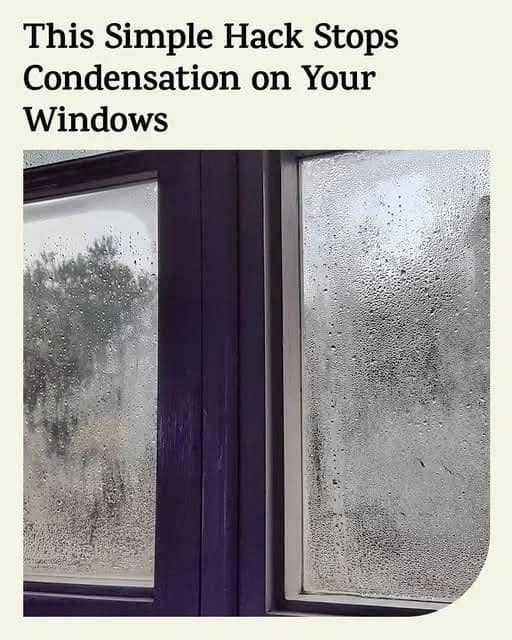As winter blankets the landscape, our homes can face a common adversary: window condensation. The sight of foggy windows can be a persistent woe during colder months, but fear not!

In this guide, we explore easy and effective ways to eliminate winter window condensation, focusing on harnessing the power of radiators. Bid farewell to the blurred views and moisture troubles as we unveil simple hacks to keep your windows crystal clear.
Winter Window Woes? Radiant Solutions to Beat Condensation!
Why Does Winter Window Condensation happen?
Window condensation occurs when warm, moist air comes into contact with a cooler surface…leading to the transformation of water vapor into liquid water. The primary reasons for window condensation can be attributed to the following factors:

- Temperature Differential: The most common cause of window condensation is a significant temperature difference between the warm interior of a home and the cooler exterior. When warm, humid indoor air meets the cold surface of a window. The air is unable to hold as much moisture, resulting in condensation on the window.
- High Humidity Levels: Elevated humidity levels within a home, often due to activities like cooking, bathing, or using certain appliances, contribute to increased moisture in the air.
When this humid air comes into contact with cooler window surfaces. It releases excess moisture in the form of condensation. - Poor Ventilation: Inadequate ventilation inhibits the exchange of indoor and outdoor air, allowing moisture to accumulate inside the home. Without proper ventilation, humid air becomes trapped indoors, increasing the likelihood of condensation on windows.

- Energy-Efficient Windows: Modern, energy-efficient windows are designed to minimize heat transfer, making them cooler to the touch. While energy-efficient windows offer benefits in terms of insulation…their cooler surface temperature can lead to more pronounced condensation when warm, moist air contacts them.
- Window Placement: Windows in areas with poor insulation or where cold outdoor air directly impacts them are more prone to condensation. Cold air from the outside cools the window surface, causing condensation when it comes into contact with warm indoor air.
- Radiator Proximity: Radiators or heating sources placed beneath or near windows can contribute to localized temperature variations. The heat from the radiator warms the adjacent air, leading to increased moisture content that can result in condensation on the nearby window.
Ideal temperature to avoid condensation
Maintaining the ideal temperature to minimize condensation involves finding a balance. That prevents significant temperature differentials between the interior and exterior surfaces of windows. The recommended indoor temperature to avoid condensation typically falls within the range of 68 to 72 degrees Fahrenheit (20 to 22 degrees Celsius). Here’s a breakdown of why this range is considered ideal:

- Balanced Comfort:
Keeping the indoor temperature between 68 and 72 degrees Fahrenheit provides a comfortable environment for occupants.
Extreme temperatures, whether too hot or too cold, can contribute to condensation. The recommended range strikes a balance that reduces the risk of moisture accumulation.
- Consistent Heating:
Maintaining a consistent indoor temperature ensures that heat is evenly distributed throughout the home.
Minimizing Cold Spots: Cold spots near windows are a common trigger for condensation. A steady temperature reduces the likelihood of significant temperature differentials at window surfaces.

- Compatible with Energy-Efficient Windows:
Energy-efficient windows are helpful to perform optimally within a specific temperature range.
Condensation Prevention: The suggested indoor temperature aligns well with the capabilities of energy-efficient windows…helping to prevent condensation issues associated with these types of windows.
- Humidity Control:
Complementary Humidity Levels: Maintaining a temperature between 68 and 72 degrees Fahrenheit is often accompanied by relative humidity levels of around 30% to 50%.
Humidity Regulation: This humidity range is conducive to minimizing moisture in the air, reducing the likelihood of condensation on window surfaces.

- Occupant Comfort and Health:
Comfortable Living Conditions: The recommended temperature range supports a comfortable living environment for occupants.
Health Considerations: Additionally, maintaining a temperature within this range is necessary for overall health and well-being.
Tips for Temperature Management to Prevent Condensation:

- Avoid Drastic Temperature Changes: Gradual adjustments in thermostat settings can help prevent rapid temperature differentials.
- Ensure Adequate Ventilation: Proper ventilation, including using exhaust fans and allowing fresh air circulation, aids in moisture control.
- Consider Radiator Placement: Position radiators strategically to distribute heat evenly, minimizing localized temperature variations near windows.
- Regular HVAC Maintenance: Ensure that your heating, ventilation, and air conditioning (HVAC) system is well-maintained to operate efficiently.
Implement these strategies into your winter routine, and transform your home into a cozy haven where foggy windows are a thing of the past. Say goodbye to winter window woes, and revel in a season filled with warmth, clarity, and comfort.


